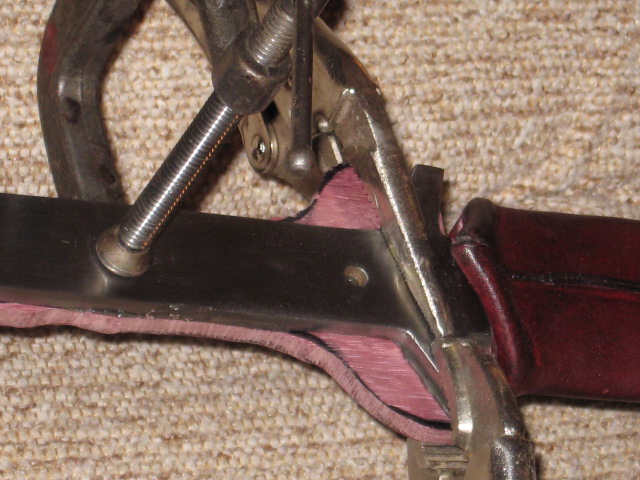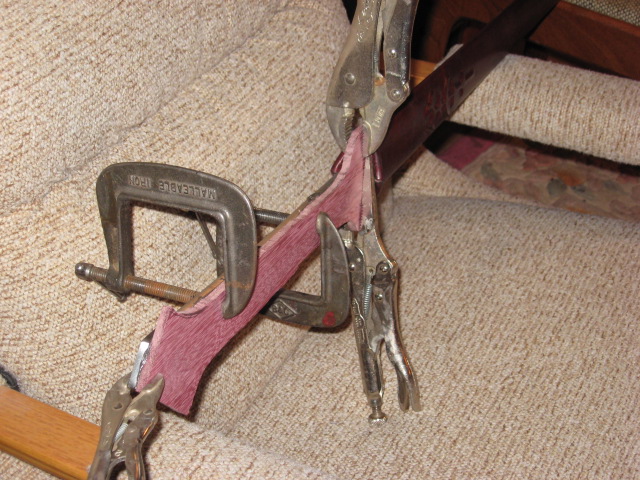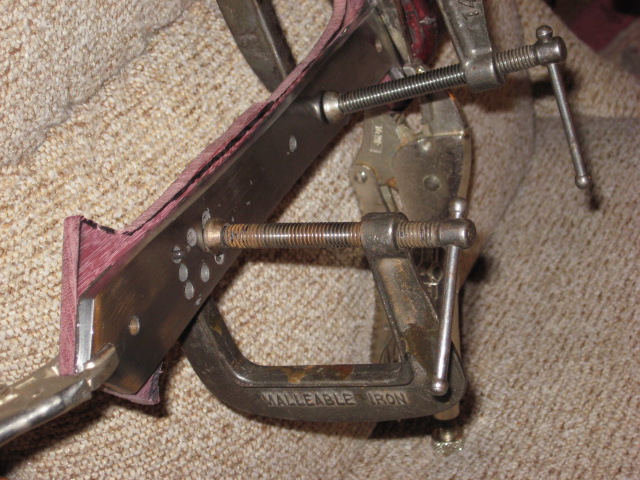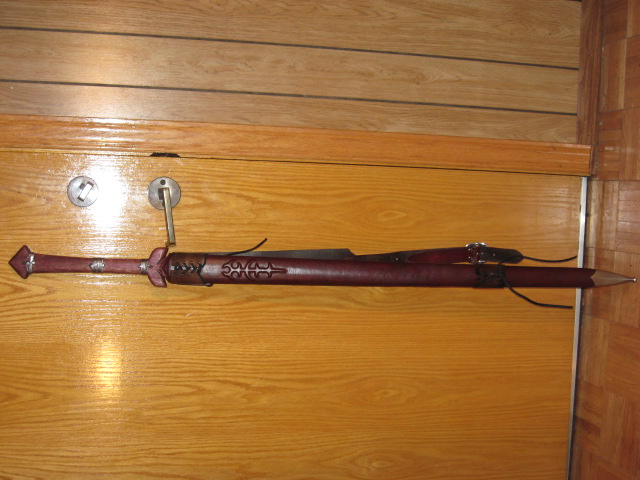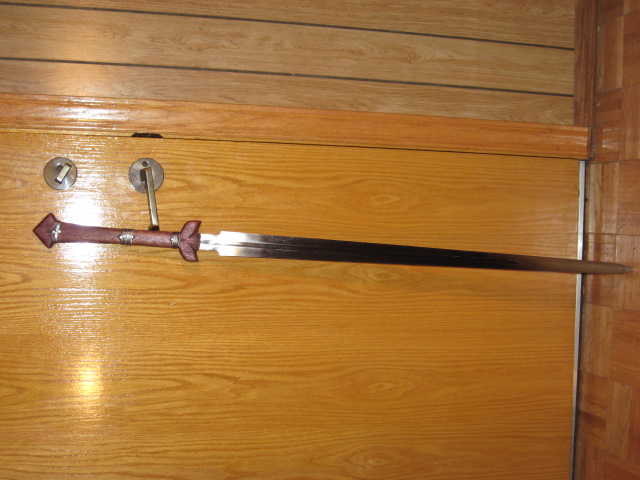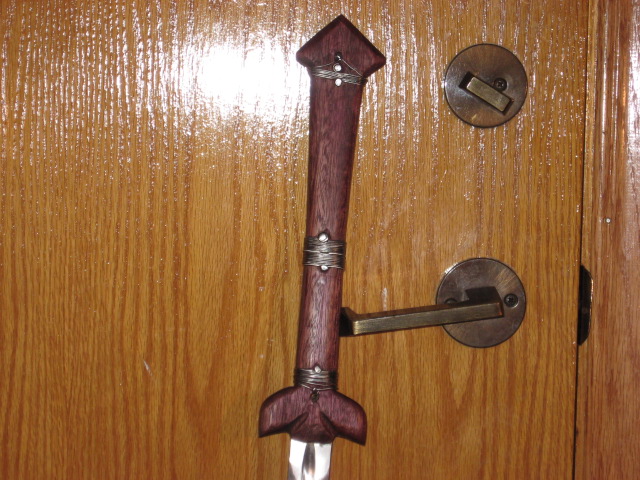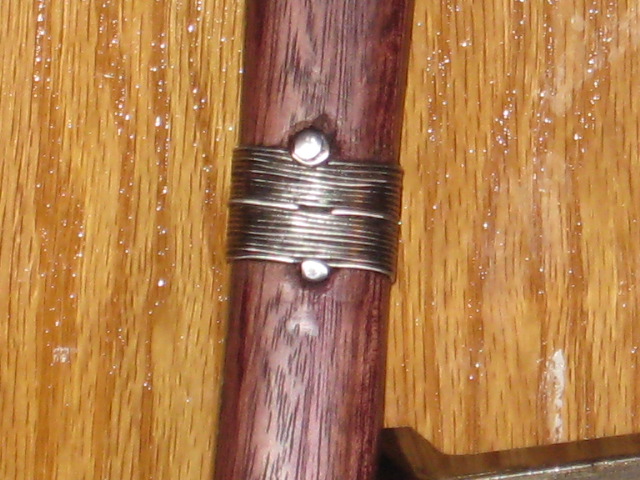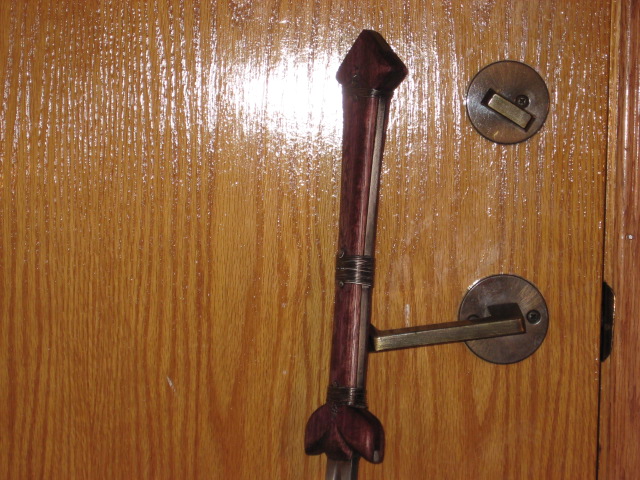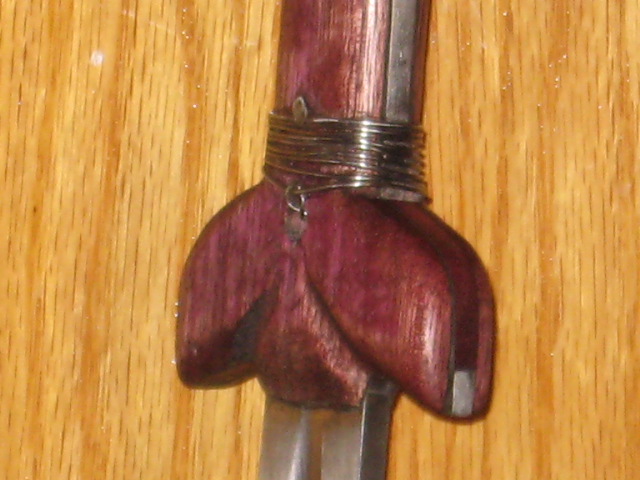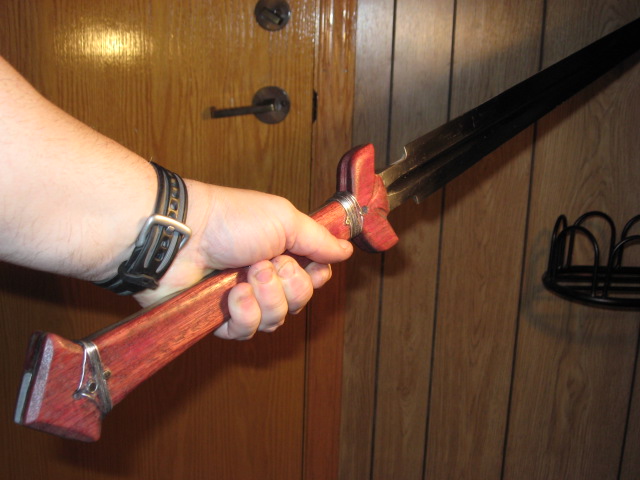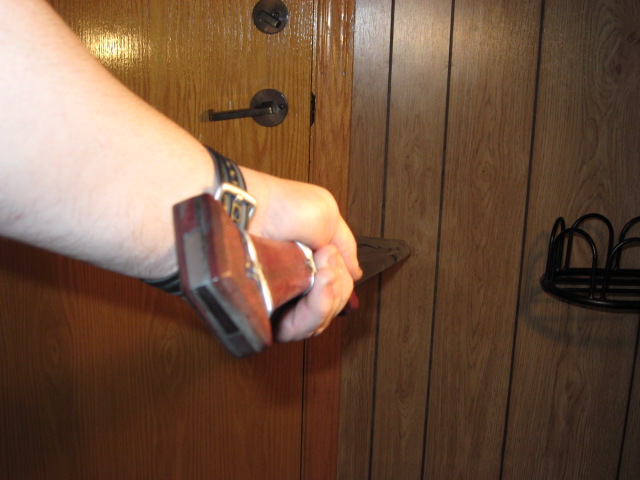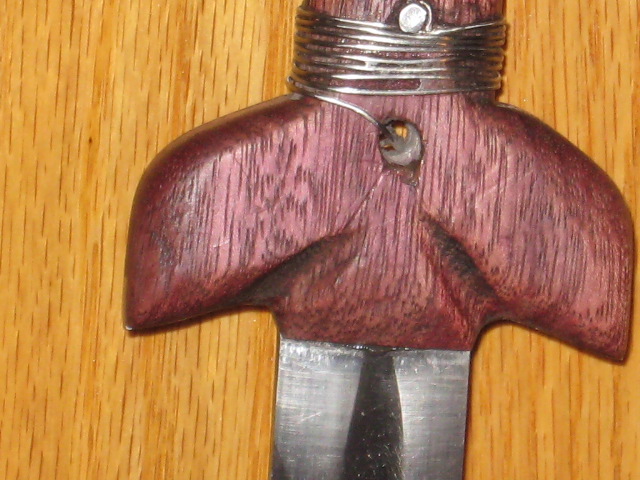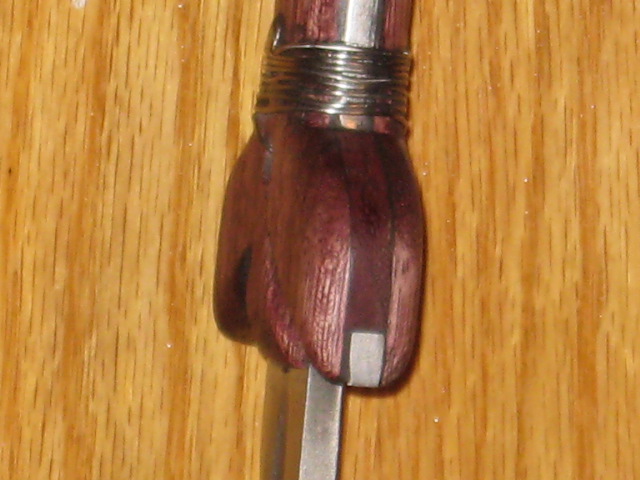Used Jatoba for the scales and used some stainless steel wire wrap at the ends and at the middle.
This being a first attempt at using a wire wrap, even if only for short sections of the handle, I found it difficult to get it really neat and the very stiff wire didn't make it any easier for me.
On the plus side, a certain crude and rude improvised look is what I wanted to fit with the concept of a Zombie Slayer sword: The back story I have in mind is that after years of fighting and surviving Zombie attacks the grip needed replacement and the work was dome with found materials while hiding in some basement refuge during a long cold Winter.
Maybe old but still usable two part epoxy, stainless steel wire and the wood salvaged from a hardware store also selling exotic woods before the Zombie Apocalypse. ;) :lol:
After removing the original leather scales here is an explanation of my assembly process below:
There are 3 holes that make sense to me: One just behind the guard, one in the middle and one near the end of the tang.
The grouping of holes between the middle one and the one at the end of the tang form a square pattern but I don't see a use for them unless they are there to fine tune the POB of the blade or something ?
Before I cleaned the tang there was a lot of residue from the adhesive used to glue the original handle onto the tang, but this is not really a pattern.
In short:
A) Remove original handle.
B) Draw on one piece of " Jatoba " a rough outline of the grip scales, cut it out with a coping saw.
C) Glue one scale onto the tang with epoxy.
D) Cut small wood inserts for the guard and pommel and glue them on, file these inserts flush with the surface of the tang where they where too thick and use a lot of epoxy to compensate for gaps at the other end where the inserts where just a little to thin and where below being flush with the tang. ( Used a steel epoxy that could fill large gaps )
E) Cut and glued on the other scale. ( Since the tang wasn't perfectly flat I used slow curing epoxy and a toothpick to push in epoxy into some of the gaps between the wood scales and the steel tang ).
F) Refine the outline with rasp and files.
G) Round the edges and at the same time trying to get the outline symmetrical, but it's not perfectly symmetrical, just generally " eyeballed " symmetrical a bit like Medieval period work that often was a little off in dimensional regularity.
H) Sand out tool marks.
I) Add the wire wrap and oil the wood.
Definitely not the conventional way a handle is built and put on a tang.
Note: The stainless steel wire was too stiff and hard to bend in a way that it wanted to spring back and loosen, had to pull very hard on the wire with pliers and hammer lightly the wire to get it to stay in contact with the wood, as I progressed I put on the wood drops of crazy glue that sort of helped keep thing down and the tacks really help in tying things down: Where possible I started to drive the tack and wound a bit of wire around it before driving it home. The crazy glue doesn't hold everywhere below the wire but it does keep it from shifting. ( Could have used four hands to be able to tension the wire, hammer it down and glue it all at the same time ).
Difficulties, the flats of the tang where not perfectly flat: Irregular finishing of the flats of the tang that curved down a little near the butt end and also at the integral guard the tang seems to be a little thinner + the ends of the guard also curve a little and have some sloppy grinding: In short the surface wasn't given a final grind with any great care or precision, but this didn't make much difference with the leather scales and enough epoxy under pressure would fill in the gaps. ( Note the first scale I glued on seemed to lie flat but the other side of the tang gave me problemsL After it was glued with 5 minute epoxy I notice that I could see " air " for maybe 35% of the length of the tang and some more extreme gapping at the ends. I used very slow clear epoxy to get it to fill the gaps using a toothpick and pushing in epoxy as deep in as I could ).
The scales where shaped after being glued onto the tang, I could have kept them the same in profile as the tang and integral guard, but I wanted to have more " meat " around the guard and at the pommel end I needed something that would harmonized at the other end. By the way I was thinking a bit of the wooden grips and guards of the Roman Gladius but also a bit of the look of the Ballock dagger hilts...... LOL.
Part of the difficulties was in trying to use the holes as the original plan was to form a loop of wire passing through the holes and thread back the wire through the loop before wrapping on each side of the holes and tucking the ends of the wire under the wrap + the tacks ...... too stiff a wire made this a " nightmare " : If one could tack one end securely and be able to use a lot of tension one could get a neat wrap and then tack it at the other end without having to depend on crazy glue. ( I could have abandoned the wire idea and done the wrap using glued down nylon cord, which is a bit silvery, or some more organic looking natural fibre cord ).
One other problem is avoiding kinks or bends in the wire and use it when it comes off the spool as cleanly as possible: This problems happens if one bend the wire in a wrong way and has to unwrap and rewrap and the bends happen in another place than the original bend ..... getting the wire cleanly wrapped and close together starts to look sloppy with gaps and irregularities.
The look of the handle sort of reminds me of the Roman Gladius in being mostly just wood, but also reminds me a bit of a Ballock Dagger handle at the guard.
The pics are first of the Zombie slayer as purchased followed by some in progress pics and finally the finished sword and handle that feels very much more comfortable.
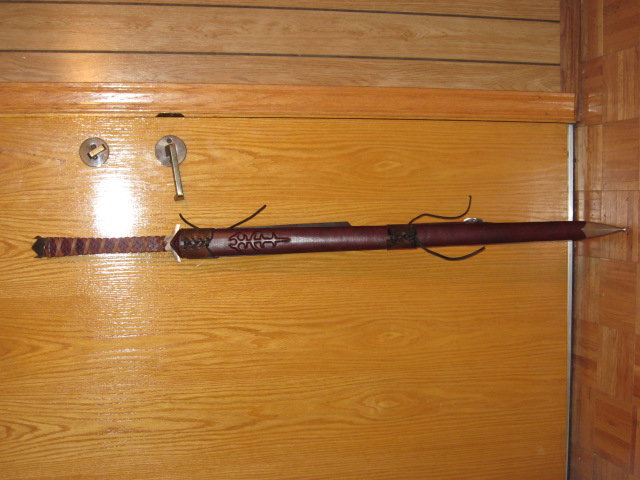
As purchased.
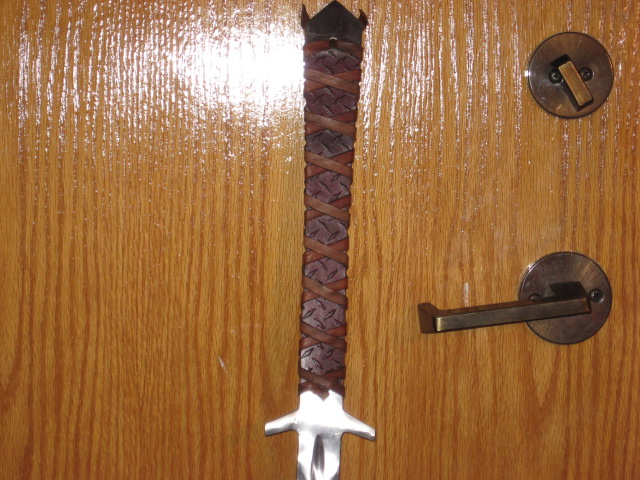

Close up of integral guard.
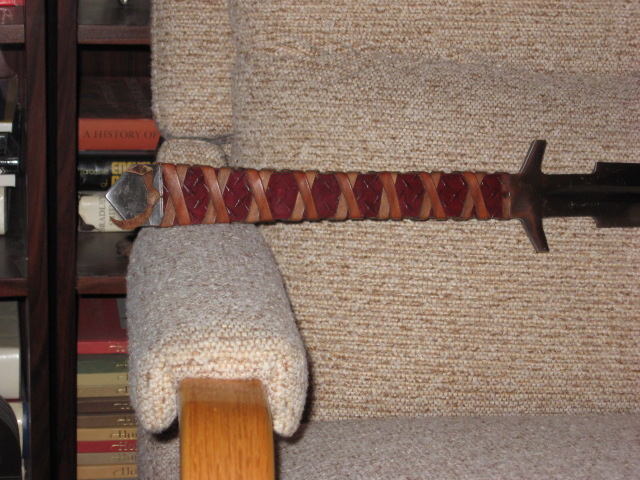
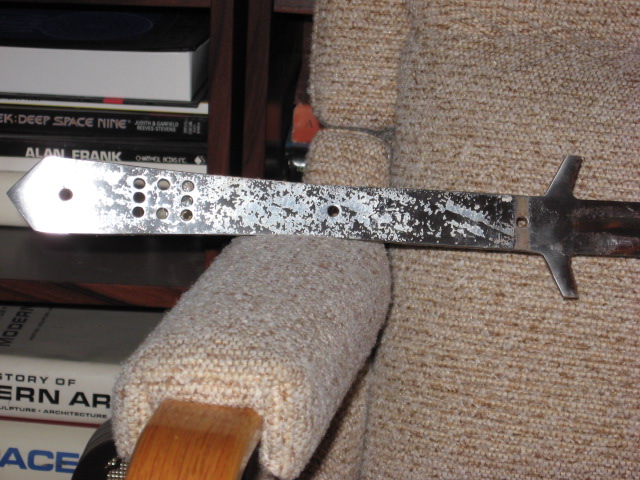
Handle stripped off.
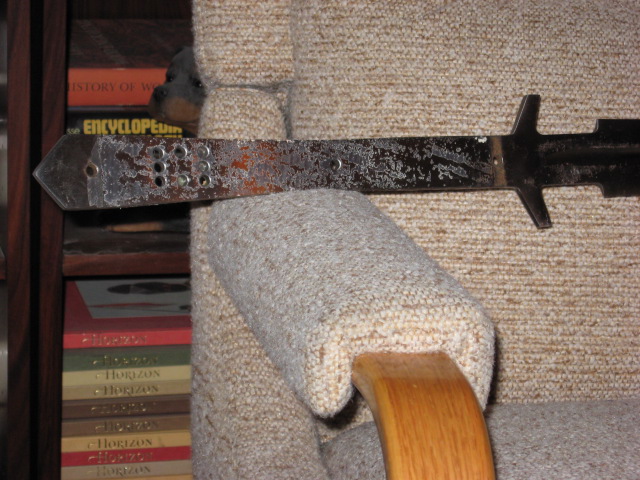

Close up of group of mystery holes in a square pattern ?

Outline drawn on Jatoba.

